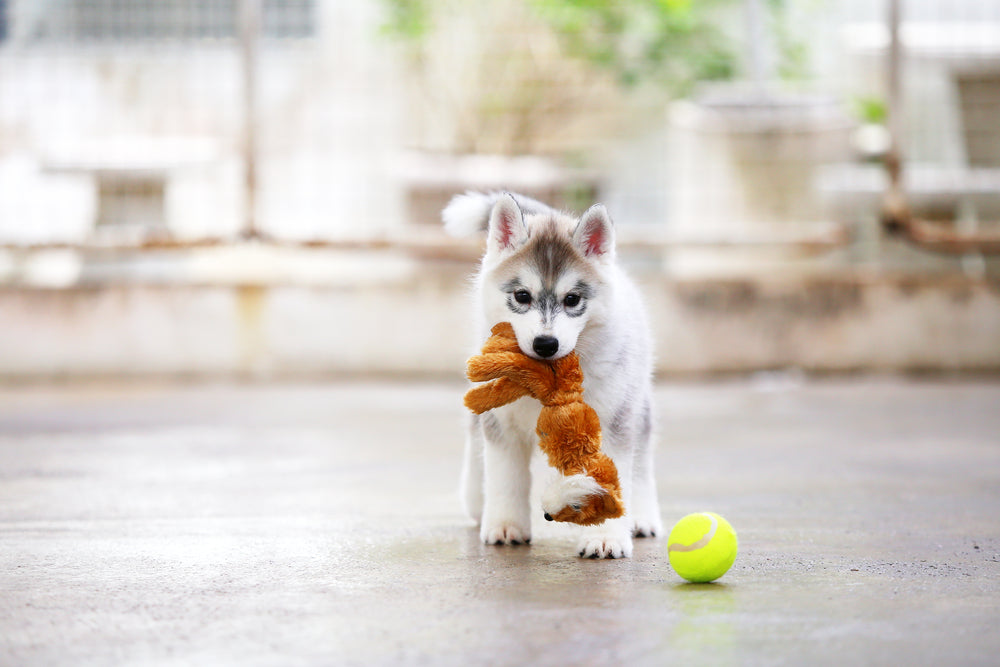
How to raise a calm puppy
Your new puppy is rambunctious, feisty ... and very adorable. And this makes it easy to overlook behaviors you may not appreciate once your puppy is grown up. And right now, you are living in the moment with your puppy: playing with him, taking hundreds of photos to share on social, house training him and getting him to sleep through the night.

But it's important to think about the kind of dog you want him to grow up to be. For many of us, an ideal pet might be summed up in a single word: calm. You want a playful dog involved in family activities, but it's also nice if his baseline personality is grounded in serenity — an easy-going dog that's a joy to be around. And right now, when your puppy is small and impressionable, is a great time to work on that. Let's look at some tips on how to raise a calm puppy.
Start with a Tranquil Atmosphere
It may surprise you, but you can control a lot of your new puppy's environment. And keeping her new environment as quiet and stress-free as possible can help her grow up to be calm. It starts with the first few nights, when your puppy may still miss her litter mates and mother. She's used her mother's warmth and soothing heartbeat sounds, so it's important to recreate this comfort for your pup. Get her a cozy crate for security, comfy blankets and a pet bed that helps create a sense of calm, like the K&H Mother's Heartbeat Heated Puppy Pet Bed with Bone Pillow. The pet bed includes a heartbeat pack that mimics a mother dog's heartbeat sounds and vibrations and can be inserted into either the bed or the pillow, helping to reassure your puppy that everything is all right.
Socialize with People and Other Dogs
We've all met dogs that never adjusted after being poorly socialized as puppies. These dogs might jump up on strangers, try to "mouth" your hand without actually biting, or pull on their leash in public. None of these behaviors are found in a calm dog. Proper early training and puppy classes can help eliminate and prevent many of these behaviors and help your dog stay calm around other animals and people.
As you socialize your puppy, there are two important tips to help you succeed:
- Leash training is super important. There is a time and place for off-leash fun in a safe, fenced-in setting where your dog knows it's time to play. But on a leash, it's best your dog understands it's time to focus and enjoy the walk without the antics. You have the greatest chance of success when you start training your puppy when they're around 8 to 10 weeks old. Start by introducing him to the leash and harness in a calm setting, then focus on the basics of leash training. You can do all this indoors in an area your puppy is used to, where distractions (and new smells) are minimal.
- Get him out and about. A great puppy calming trick is to have him meet plenty of new people and other dogs while he's young (after he's been vaccinated). You could invite friends over to introduce your puppy to a variety of new people, arrange puppy play dates to help your puppy socialize with other dogs or take him on short errands with you around town (and some places even keep dog treats!).
Anticipate "Exciting" Situations
While it's impossible to think of everything, try to anticipate situations that may be really exciting or even scary to your pup. It's a good idea to spend time desensitizing her to those situations while she's still a puppy. Consider situations like:
- People at the door. Some dogs take the “watchdog" badge too far: excessively and excitedly barking, running around or jumping when a visitor is on the porch. Puppyhood is a time to show your pet that none of this is a big deal. Give your furry BFF a calm and quiet “This-is-fine-it's-no-big-deal-nobody-gets-excited-about-a-box-on-the-porch" type of leadership. Think about the routine your puppy is learning: exciting things (like a guest's arrival) happen when the doorbell rings. You can intervene by teaching your puppy the "place" command, where she's rewarded for going to her designated spot when the doorbell rings. Her "place" could be something like a pet cot.
- Loud noises. Many adult dogs have a true fear of fireworks or the sound of thunderstorms. You obviously can't exactly reproduce firework noises or the window-rattling sensations of a thunderstorm in your home, but you can help your puppy acclimate to similar, quieter noises. Again, it's all about creating a “no problem!" atmosphere so your puppy doesn't start to associate the noise with fear — just treats or toys. A heartbeat pillow can be a way for a puppy to find comfort in noisy situations.
Wear that Puppy Down — Literally
Puppies are full of energy, regardless of if your pup's breed is a couch potato (like a Corgi) or a high-performing athlete (like an Australian Shepherd). Providing your pup with ample playtime and exercise on a consistent routine will help tame the wiggles. Be sure to research your breed's daily exercise requirements (the American Kennel Club, Chewy or your breed's official club are great resources). Playtime doesn't always equal long walks, hikes or adventures. Toys that engage the brain (like a snuffle mat or treat puzzle) can also help give your puppy avenues to expend excess energy.
You can raise a calm puppy.
Take the lead and demonstrate to your puppy what calm is. They really do pay attention to your demeanor and body language. Avoid encouraging your puppy when he's acting too excitable. It's important you remain calm and remember to reward him with treats when he is calm. You can raise a calm puppy and enjoy many years with a calm dog for your efforts.




Leave a comment